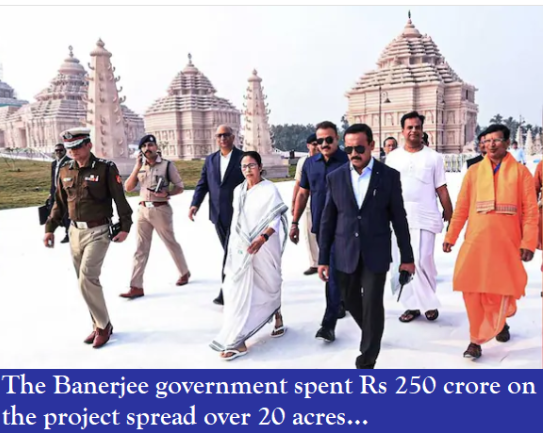Hindutva Emerges as a Strong Political Force in West Bengal Through TMC’s Temple Politics
The landscape of West Bengal politics is undergoing a significant transformation, with religious identity becoming increasingly prominent in the state’s political discourse. The recent inauguration of a Lord Jagannath Temple in Digha, East Medinipur, by the ruling Trinamool Congress (TMC) government led by Chief Minister Mamata Banerjee is a clear indication of this shift.
Unlike the Ram Temple in Ayodhya, which was not sponsored by the government, the Digha temple was constructed by the state government at a cost of Rs 250 crore. The temple’s design, inspired by the famous Lord Jagannath Temple in Puri, Odisha, holds deep significance in Hinduism and is expected to boost tourism in Digha.
The TMC’s strategic focus on promoting Hindu religious identity is a departure from its earlier leftist leanings. Historically, Banerjee had aligned herself with Left-oriented politics, positioning herself as the inheritor of the state’s leftist legacy. However, as the Communist Party of India (Marxist) began to lose ground, Banerjee recognized the need to adopt a more inclusive approach to counter the growing influence of the saffron party.
The TMC’s efforts to renovate and promote Hindu temples across the state, coupled with the construction of the Digha temple, are part of a larger strategy to appeal to the state’s Hindu majority. This shift in strategy has allowed the TMC to consolidate its support base and maintain its dominance in state politics.
However, the rise of Hindutva in West Bengal presents challenges for the ruling party. The BJP’s growing influence in the state, coupled with incidents of violence against minority Hindus, has the potential to erode the TMC’s support among Hindu voters who feel marginalized by the party’s minority appeasement policies.
As the state gears up for assembly elections next year, the TMC faces the daunting task of balancing its appeal to religious minorities while addressing the concerns of its Hindu voter base. The BJP’s success in neighboring Odisha serves as a cautionary tale for the TMC, highlighting the limitations of regionalism in the face of a resurgent Hindutva movement.
In this evolving political landscape, the TMC’s temple politics and strategic focus on promoting Hindu identity serve as a crucial tool to counter the BJP’s growing influence in West Bengal. The upcoming state elections will test the effectiveness of the TMC’s efforts to appeal to the state’s diverse religious and cultural identities and solidify its position as a formidable political force in the region.
Opinions are Personal

